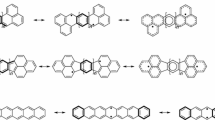Summary
Pentacoordinated molecules are thought to undergo intramolecular isomerization by the widely accepted Berry pseudorotation mechanism. Through our investigations, we have found that the actual pseudorotation for the PH4F system is more complex than that envisioned by Berry. The potential energy surface of PH4F is mapped out at the RHF/6-311G(d, p) level. According to the Berry mechanism, this system is expected to have two minima and two maxima; however, the system actually has two transition states and one global minimum. The minimum energy path from the highest transition state is followed to the second transition state, which in turn has a minimum energy path leading to the global minimum. Along the path between the two transition states there is a branching region. This portion of the potential energy surface is probed extensively.
Similar content being viewed by others
References
Berry RS (1960) J Chem Phys 32:933
Mislow K (1970) Acc Chem Res 3:321
Gordon MS, Windus TL, Burggraf LW, Davis LP (1990) J Am Chem Soc 112:7167
Windus TL, Gordon MS, Burggraf LW, Davis LP, J Am Chem Soc 113:4346
Deiters JA, Holmes RR (1990) J Am Chem Soc 112:7197
Magnusson E (1990) J Am Chem Soc 112:7940
Breidung J, Thiel W, Kormornicki A (1988) J Phys Chem 92:5603
Strich A, Veillard A (1973) J Am Chem Soc 95:5574
Keil F, Kutzelnigg W (1975) J Am Chem Soc 97:3623
McDowell RS, Streitwieser A Jr (1985) J Am Chem Soc 107:5849
Wang P, Zhang Y, Glaser R, Reed AE, Schleyer PvR, Streitwieser A (1991) J Am Chem Soc 113:55
Francl MM, Pietro WJ, Hehre WJ, Binkley JS, Gordon MS, DeFrees DJ, Pople JA (1982) J Chem Phys 77:3654
Hehre WJ, Ditchfield R, Pople JA (1972) J Chem Phys 56:2257
Ditchfield R, Hehre WJ, Pople JA (1971) J Chem Phys 54:724
Hariharan PC, Pople JA (1973) Theor Chim Acta 28:213
Krishnan R, Binkley JS, Steeger R, Pople JA (1980) J Chem Phys 72:650
McLean AD, Chandler GS (1980) J Chem Phys 72:5639
Pople JA, Binkley JS, Seeger R (1976) Int J Quantum Chem S10:1
Baldridge KK, Gordon MS, Steckler R, Truhlar DG (1989) J Phys Chem 93:5107
Miller WH, Handy NC, Adams JE (1980) J Chem Phys 72:99
Boatz JA, Schmidt MW implemented in GAMESS in 1986. See [15]
Schmidt MW, Baldridge KK, Boatz JA, Jensen JH, Koseki S, Gordon MS, Nguyen KA, Windus TL, Elbert ST (1990) QCPE Bull 10:52
Frisch MJ, Binkley JS, Schlegel HB, Raghavachari K, Melius CF, Martin RL, Stewart JJP, Bobrowicz FW, Rohlfing CM, Kahn LR, DeFrees DJ, Steeger R, Whiteside RA, Fox DJ, Fleuder EM, Pople JA Carnegie-Mellon Quantum Chemistry Publishing Unit Pittsburgh PA 15213
Ugi I, Ramirez F (1972) Chem Br 8:198
Kutzelnigg W, Wasilewski J (1982) J Am Chem Soc 104:953
Wang P, Argafiotis DK, Streitwieser A, Schleyer PvR (1990) J Chem Soc, Chem Comm 201
Hoffman DK, Nord RS, Ruedenberg K (1986) Theor Chim Acta 69:265
Valtazanos P, Ruedenberg K (1986) Theor Chim Acta 69:281
Kraus WA, DePristo AE (1986) Theor Chim Acta 69:309
Baker J, Gill PMW (1988) J Comp Chem 9:465
Shida N, Almlöf JE, Barbara PF (1989) Theor Chim Acta 76:7
One of the reviewers has noted that an alternative explanation is “that the BP's, being non-symmetric, follow neither the downhillB 2 orA 1 modes per se, but must first jump over a small region of hypersurface which is higher in energy. Depending on the PIP, this may be a small or a large first step.”
Wilson EB, Jr., Decius JC, Cross PC (1955) Molecular Vibrations, McGraw-Hill, New York Toronto London
Author information
Authors and Affiliations
Additional information
Dedicated to Prof. Klaus Ruedenberg
Rights and permissions
About this article
Cite this article
Windus, T.L., Gordon, M.S. A detailed analysis of pseudorotation in PH4F. Theoret. Chim. Acta 83, 21–30 (1992). https://doi.org/10.1007/BF01113241
Received:
Accepted:
Issue Date:
DOI: https://doi.org/10.1007/BF01113241




